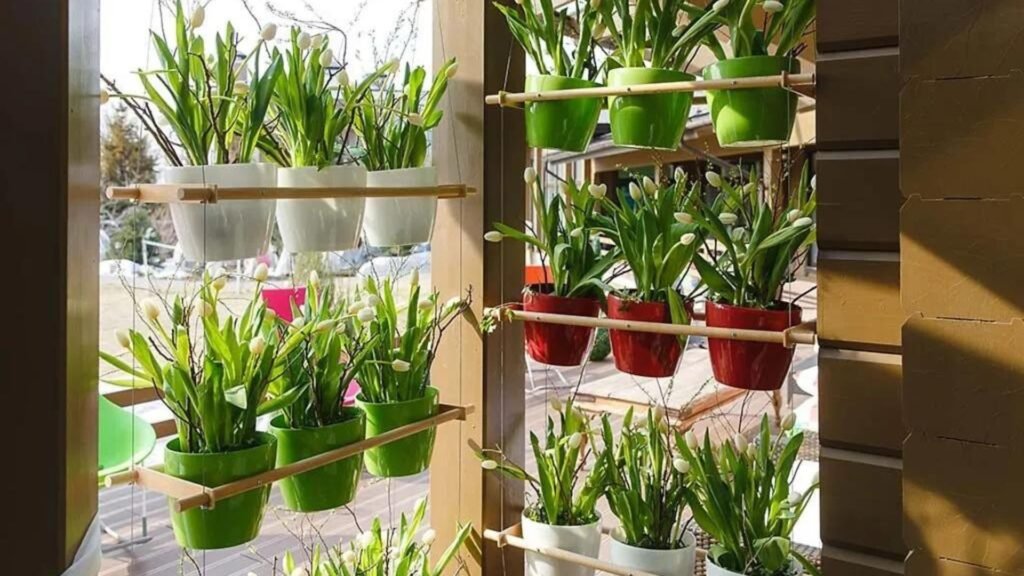How to Create a Vertical Garden with Potted Plants
Creating a vertical garden with potted plants is an excellent way to maximize space, add greenery to your living area, and create a stunning visual display. Whether you have limited outdoor space or simply want to enhance your indoor decor, a vertical garden can be a beautiful and practical solution. Here are some essential tips on how to create a vertical garden with potted plants.

Choose the Right Location
The first step in creating a vertical garden with potted plants is selecting the right location. Consider the following factors:
- Light: Ensure the location receives adequate light for the plants you choose. South-facing walls typically get the most sunlight, while east or west-facing walls receive moderate light. If you’re creating an indoor vertical garden, choose a spot near a window or use grow lights.
- Space: Assess the available space and decide how large you want your vertical garden to be. Measure the area to ensure your design fits perfectly.
- Accessibility: Make sure the location is easily accessible for watering and maintenance. You don’t want to place your garden in a spot that’s difficult to reach.
Select Suitable Plants
Choosing the right plants is crucial for the success of your vertical garden. Here are some plant options that work well in vertical gardens:
- Herbs: Basil, mint, parsley, and thyme are excellent choices for an edible vertical garden.
- Succulents: These low-maintenance plants, such as echeveria, sedum, and aloe, thrive in vertical gardens.
- Ferns: Boston fern and maidenhair fern add lush greenery and do well in shaded or partially shaded areas.
- Flowers: Petunias, begonias, and pansies can add vibrant color to your vertical garden.
- Vines: Plants like pothos, ivy, and philodendron are ideal for creating a cascading effect.
Select the Right Containers
Choosing the right containers for your vertical garden is essential for both aesthetics and plant health. Here are some container options:
- Hanging Pots: These are perfect for creating a cascading effect with trailing plants.
- Wall Planters: These can be mounted directly on the wall and come in various shapes and sizes.
- Pocket Planters: Fabric pocket planters are lightweight and can hold multiple plants.
- Recycled Containers: Get creative with recycled containers like old shoe organizers, pallets, or wooden crates.
Install a Support Structure
A sturdy support structure is necessary to hold your potted plants in place. Here are some ideas:
- Trellis: A trellis can support climbing plants and hold pots with hooks or brackets.
- Grid Panels: Metal or wooden grid panels provide a framework for attaching pots and planters.
- Shelves: Installing shelves on the wall can create levels for displaying potted plants.
- Hanging Rods: Use curtain rods or tension rods to hang pots with hooks or S-hooks.
Prepare the Soil
Good quality soil is vital for the health of your plants. Here’s how to prepare the soil for your vertical garden:
- Use Potting Mix: Choose a high-quality potting mix that provides good drainage and aeration. Avoid using garden soil, as it can be too heavy and compacted for potted plants.
- Add Fertilizer: Mix in a slow-release fertilizer to provide essential nutrients to your plants over time.
- Check pH Levels: Ensure the soil pH is suitable for the plants you’ve chosen. Most plants thrive in slightly acidic to neutral soil.
Plant Your Garden
Once everything is set up, it’s time to plant your vertical garden. Follow these steps:
- Arrange the Pots: Arrange your pots and planters on the support structure before planting to visualize the final look.
- Plant Selection: Start with the largest plants at the bottom and smaller plants at the top. This arrangement ensures all plants receive adequate light and water.
- Planting: Fill each pot with soil, create a small hole for each plant, place the plant in the hole, and gently press the soil around the base to secure it.
Watering and Maintenance
Proper watering and maintenance are crucial for the success of your vertical garden. Here’s how to keep your garden thriving:
- Watering: Water your plants regularly, but avoid overwatering. Ensure the water reaches the roots without causing waterlogging. Consider using a drip irrigation system for consistent watering.
- Pruning: Regularly prune your plants to encourage healthy growth and prevent overcrowding. Remove dead or yellowing leaves to maintain the garden’s appearance.
- Fertilizing: Feed your plants with a balanced liquid fertilizer every few weeks during the growing season to promote healthy growth.
- Pest Control: Monitor your plants for pests and diseases. Use natural pest control methods like neem oil or insecticidal soap to manage any issues.
Conclusion
In conclusion, creating a vertical garden with potted plants involves choosing the right location, selecting suitable plants and containers, installing a support structure, preparing the soil, planting your garden, and ensuring proper watering and maintenance. By following these tips for creating a vertical garden with potted plants, you can transform any space into a lush, green oasis that brings beauty and tranquility to your home.



